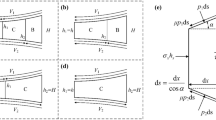Abstract
The minimum rolling thickness in asymmetrical rolling was analyzed compared with that in symmetrical rolling. The differential equilibrium equations on forces were established to calculate the asymmetrical rolling force equation by slab method. An implicit expression of the minimum rolling thickness was then derived from the rolling force equation and Hitchcock equation. The results show that permissible minimum rolling thickness of asymmetrical rolling only exists within a specific range of cross-shear ratio, which is termed the cross-shear zone proportion of the whole deformation zone. Numerical computation was carried out to obtain a discrete solution of the minimum rolling thickness. Experiments were designed to investigate the influence factors on cross-shear ratio. Finally, experimental results prove the correctness of the improved formula given.
Similar content being viewed by others
Abbreviations
- C 0 :
-
Constant
- E 1 :
-
Elastic modulus of work piece
- E 2 :
-
Elastic modulus of work roller
- f:
-
Friction coefficient
- Δh:
-
Thickness difference of entrance and exit
- h̄:
-
Average thickness of entrance and exit
- h:
-
Thickness in exit of deformation region
- H:
-
Thickness in entrance of deformation region
- h min :
-
Permissible minimum thickness
- i:
-
Asymmetrical ratio
- K:
-
Plane deformation resistance
- l:
-
Arc length of contact
- l′:
-
Arc length of contact considering elastic deformation of rolling piece and rollers
- P:
-
Rolling force
- p̄:
-
Average unit rolling force
- p b :
-
Average unit rolling force in backward-slip zone
- p f :
-
Average unit rolling force in forward-slip zone
- p r :
-
Average unit rolling force in cross-shear zone
- p x :
-
Average unit rolling force in whole deformation region
- R:
-
Diameter of work roller
- v:
-
Linear velocity of rollers in symmetrical rolling
- v s :
-
Linear velocity of slow rollers in asymmetrical rolling
- v f :
-
Linear velocity of fast rollers in asymmetrical rolling
- x:
-
Horizontal displacement
- ε:
-
Percentage of cross-shear zone in whole deformation region
- τ f :
-
Frictional force
- γ 1 :
-
Poison ratio of work piece
- γ 2 :
-
Poison ratio of work roller
- η c :
-
Limiting value of η.
References
Stone M D. Rolling of Thin Strip [J]. Iron and Steel Eng, 1953, 30(2): 61.
Tzou G Y, Huang M N. Study on Minimum Thickness for Asymmetrical Hot-and-Cold PV Rolling of Sheet [J]. Journal of Materials Processing Technology, 2001, 119(1): 229.
Singh P, Pandey R K, Nath Y. An Efficient Thermal Analysis for the Prediction of Minimum Film Thickness in Inlet Zone at High Speed Lubricated Cold Strip Rolling [J]. Journal of Materials Processing Technology, 2008, 200(1): 238.
Zhu Q. The Deformation Characteristics in Cross Shear Cold Rolling of Ultra-thin Strip and the Theory of ‘Elastic Stopper’ [J]. Journal of Northeast Institute of Technology, 1982, 32(3): 17.
Ford H. Researches Into the Deformation of Metals by Cold Rolling [J]. Proceedings of the Institution of Mechanical Engineers, 1948 (159): 115.
Kim W J, Yoo S J, Jeong H T, et al. Effect of the Speed Ratio on Grain Refinement and Texture Development in Pure Ti During Differential Speed Rolling [J]. Scripta Materialia, 2011, 64(1): 49.
TIAN Yong, GUO Yan-hui, WANG Zhao-dong, et al. Analysis of Rolling Pressure in Asymmetrical Rolling Process by Slab Method [J]. Journal of Iron and Steel Research, International, 2009, 16(4): 34.
Salimi M, Kadkhodaei M. Slab Analysis of Asymmetrical Sheet Rolling [J]. Journal of Materials Processing Technology, 2004, 150(3): 215.
Aurelie Wauthier, Helene Regle, Jorge Formigoni, et al. The Effects of Asymmetrical Cold Rolling on Kinetics, Grain Size and Texture in IF Steels [J]. Materials Characterization, 2009, 60(2): 90.
WANG Jun-li, SHI Qing-nan, QIAN Tian-cai, et al. Recrys-tallized Microstructural Evolution of UFG Copper Prepared by Asymmetrical Accumulative Rolling-Bonding Process [J]. Transactions of Nonferrous Metals Society of China, 2010, 20(4): 559.
Wronski S, Ghilianu B, Chauveau T, et al. Analysis of Textures Heterogeneity in Cold and Warm Asymmetrically Rolled Aluminium [J]. Materials Characterization, 2011, 62(1): 22.
Laszlo S Tóth, Benoit Beausir, Dmitry Orlov, et al. Analysis of Texture and R Value Variations in Asymmetric Rolling of IF Steel [J]. Journal of Materials Processing Technology, 2012, 212(2): 509.
Gudur P P, Salunkhe M A, Dixit U S. A Theoretical Study on the Application of Asymmetric Rolling for the Estimation of Friction [J]. International Journal of Mechanical Sciences, 2008, 50(20): 315.
Akbari Mousavi S A A, Ebrahimi S M, Madoliat R. Three Dimensional Numerical Analyses of Asymmetric Rolling [J]. Journal of Materials Processing Technology, 2007, 187–188(12): 725.
Lee Jong-Kook, Lee Dong Nyung. Texture Control and Grain Refinement of AA1050 Al Alloy Sheets by Asymmetric Rolling [J]. International Journal of Mechanical Sciences, 2008, 50(5): 869.
Author information
Authors and Affiliations
Corresponding author
Additional information
Foundation Item: Item Sponsored by National Natural Science Foundation of China (50974039)
Rights and permissions
About this article
Cite this article
Tang, Dl., Liu, Xh., Li, Xy. et al. Permissible Minimum Thickness in Asymmetrical Cold Rolling. J. Iron Steel Res. Int. 20, 21–26 (2013). https://doi.org/10.1016/S1006-706X(13)60191-0
Received:
Published:
Issue Date:
DOI: https://doi.org/10.1016/S1006-706X(13)60191-0




